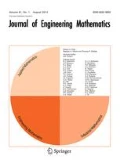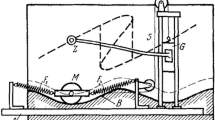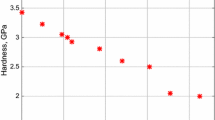Abstract
In this paper, earlier dissolutive wetting models describing the dynamics of an axisymmetric alloy drop spreading on pure metal substrate are extended to describe reactive wetting and subsequent joint formation in brazing processes. A two-dimensional time-dependent problem is formulated, and the model equations are nondimensionalized, revealing the possibilities for asymptotic model reduction. Whilst the numerical solution of the time-dependent problem, which contains two moving contact lines and would not in general be amenable to lubrication theory, is relegated to future work, the steady-state problem is analyzed in detail. The analysis offers an arguably more transparent alternative to an earlier energy minimization approach for finding the location of the meniscus, which ultimately constitutes the joint. The results of the present model are found to compare favourably to those of earlier experimental and theoretical work.








Similar content being viewed by others
References
Terrill JR (1966) Diffusion of silicon in aluminum brazing sheet. Weld Res Suppl 45:202–209
Woods RA, Robinson IB (1974) Flow of aluminum dip brazing filler metals. Weld Res Suppl 53:S440–S445
Zhao H, Salazar AJ, Sekulic DP (2009) Analysis of fin-tube joints in a compact heat exchanger. Heat Transf Eng 30:931–940
Sekulic DP, Gao F, Zhao H, Zellmer B, Qian YY (2004) Prediction of the fillet mass and topology of aluminum brazed joints. Weld J 83:102S–110S
Sekulic DP (2001) Molten aluminum equilibrium membrane formed during controlled atmosphere brazing. Int J Eng Sci 39:229–241
Zellmer BP, Nigro N, Sekulic DP (2001) Numerical modelling and experimental verification of the formation of 2D and 3D brazed joints. Model Simul Mater Sci Eng 9:339–355
Sekulic DP, Zellmer BP, Nigro N (2001) Influence of joint topology on the formation of brazed joints. Model Simul Mater Sci Eng 9:357–369
Sekulic DP (2013) Modeling of the sequence of phenomena in brazing. In: Sekulic DP (ed) Advances in brazing: science, technology and applications. Woodhead Publishing, Cambridge, pp 55–81
Warren JA, Boettinger WJ, Roosen AR (1998) Modeling reactive wetting. Acta Mater 46(9):3247–3264
Su S, Yin L, Sun Y, Murray BT, Singler TJ (2009) Modeling dissolution and spreading of Bi-Sn alloy drops on a Bi substrate. Acta Mater 57(10):3110–3122
Villanueva W, Gronhagen K, Amberg G, Ågren J (2008) Multicomponent and multiphase modeling and simulation of reactive wetting. Phys Rev E 77, Article no. 056313
Villanueva W, Boettinger WJ, Warren JA, Amberg G (2009) Effect of phase change and solute diffusion on spreading on a dissolving substrate. Acta Mater 57:6022–6036
Villanueva W, Boettinger WJ, McFadden GB, Warren JA (2012) A diffuse-interface model of reactive wetting with intermetallic formation. Acta Mater 60:3799–3814
Braun RJ, Murray BT, Boettinger WJ, McFadden GB (1995) Lubrication theory for reactive spreading of a thin drop. Phys Fluids 7:1797–1810
Racz LM, Szekely J, Brakke KA (1993) A general statement of the problem and description of a proposed method of calculation for some meniscus problems in materials processing. ISIJ Int 33:328–335
Lacaze J, Jacques B, Mazet T, Vynnycky M (2018) Numerical simulation of brazing aluminium alloys with Al-Si alloys. Trans Ind Inst Met 71:2623–2629
Leal LG (2007) Advanced transport phenomena: fluid mechanics and convective transport processes. Cambridge series in Chemical Engineering, 1st edn. Cambridge University Press, Cambridge
Singler TJ, Su S, Yin L, Murray BT (2012) Modeling and experiments in dissolutive wetting: a review. J Mater Sci 47:8261–8274
Saiz E, Cannon RM, Tomsia AP (2000) Reactive spreading: adsorption, ridging and compound formation. Acta Mater 48:4449–4462
Saiz E, Tomsia AP, Cannon RM (1998) Ridging effects on wetting and spreading of liquids on solids. Acta Mater 46:2349–2361
Poirier DR (2014) Density, viscosity, and diffusion coefficients in hypoeutectic Al-Si liquid alloys: an assessment of available data. Metall Mater Trans B 45:1345–1354
Kobatake H, Brillo J, Schmitz J, Pichon P-Y (2015) Surface tension of binary Al-Si liquid alloys. J Mater Sci 50:3351–3360
Thermo-Calc Software TCAL version 2
Gao F, Sekulic DP, Qian YY, Ma X (2003) Residual clad formation and aluminum brazed joint topology prediction. Mater Lett 57:4592–4596
Huh C, Scriven LE (1971) Hydrodynamic model of steady movement of a solid/liquid/fluid contact line. J Colloid Interface Sci 35:85–101
Seppecher P (1996) Moving contact lines in the Cahn-Hilliard theory. Int J Eng Sci 34:977–992
Ehrhard P, Davis SH (1991) Nonisothermal spreading of liquid-drops on horizontal plates. J Fluid Mech 229:365–388
Su S (2012) The development of computational models for studying wetting, evaporation and thermal transport for electronics packaging applications. Ph.D. thesis, SUNY, Binghamton
Yang J, Yuan Q, Zhao YP (2018) Evolution of the interfacial shape in dissolutive wetting: coupling of wetting and dissolution. Int J Heat Mass Transf 118:201–207
Bikerman JJ (1970) Physical surfaces. Academic Press, New York
Vynnycky M, Zambrano M, Cuminato JA (2015) On the avoidance of ripple marks on cast metal surfaces. Int J Heat Mass Transf 86:43–54
Vynnycky M, Zambrano M (2018) Towards a “moving-point” formulation for the modelling of oscillation-mark formation in the continuous casting of steel. Appl Math Mod 63:243–265
Acknowledgements
The first author acknowledges the award of a visiting researcher grant from FAPESP (Fundação de Amparo à Pesquisa do Estado de São Paulo) [Grant Number 2018/07643-8]. Both authors would like to thank the anonymous referees for their constructive comments.
Author information
Authors and Affiliations
Corresponding author
Additional information
Publisher's Note
Springer Nature remains neutral with regard to jurisdictional claims in published maps and institutional affiliations.
Appendices
Appendix A: Determining the velocity scale, \(\left[ u\right] \)
In addition to \(\left[ u\right] =D/l,\) another possibility is to take \(\left[ u\right] =D\varGamma /l^{2}.\) In this case, we have
respectively. Also, (4.5) and (4.17) become
respectively. It is now convenient to refer to Table 1, which contains the model parameters. Now, since \(\delta \ll 1,\) (A.4) and (A.5) reduce to
i.e. this is already the steady state. Also, from (A.1), we would obtain \(\left[ t\right] \sim 10^{10}\) s, and it is clear that we must have taken the wrong choice for \(\left[ u\right] .\)
Appendix B: \(\varepsilon \ll 1\)
In this case, the F and H problems decouple in an interesting way. From (5.31), and assuming that \(\mathcal {A}\sim O\left( 1\right) ,\) we now expect that
For \(Y<0,\) this should mean that \(X\sim O\left( 1\right) ,F\sim O\left( \varepsilon \right) ,\) whereas for \(Y>0,\) we expect \(F\sim O\left( 1\right) \) when \(X\sim O\left( \varepsilon \right) \).
Considering the first case, if \(F=\varepsilon \bar{F},\) with the expectation that \(\bar{F}\) is an \(O\left( 1\right) \) function, implies that (5.24) becomes, at leading order in \(\varepsilon ,\)
where \(\mathcal {C}_{2}=\mathcal {\bar{C}}_{2}/\varepsilon ,\) with \(\mathcal {\bar{C}}_{2}\) an \(O\left( 1\right) \) constant, whereas (5.28) and (5.29) reduce to
respectively. For the second case, we set \(X=\varepsilon \bar{X},\) so that (5.24) becomes
with (5.26) reducing to
Note that, at this stage, (B.2) and (B.5) are consistent with each other, and the implication is that the radius of curvature of F, which is in effect \(1/\mathcal {C}_{2},\) is small. Also, we can note that the problem for H has now decoupled from that for F. More specifically, we have, for H, Eq. (5.23) subject to
so, there are enough constraints to determine \(H,\mathcal {C}_{1}\) and \(X_{*},\) and thus \(H\left( 0\right) .\)
Returning to the problem for F, we have
subject to
and
subject to
Each of these problems is clearly missing a boundary condition, and hence two more conditions would be required. One would hope for continuity of F and its derivative, so that the two problems would “join up”, in the sense that F and \(\mathrm {d}F/\mathrm {d}X\) as computed by the two problems should be continuous at some value of X that would have to be determined. However, it is impossible to achieve this, whilst at the same time ensuring that the curvature of F is constant. Thus, the only apparent possibility is that
and hence that
which abandons the requirement that \(\mathrm {d}F/\mathrm {d}X\) is continuous. In this case, dissolution does not start at all from the point (0,0). Note that (B.15) will mean that F is multivalued at \(X=0,\) and indeed for \(X<0.\)
The remaining problem for \(\bar{F}\) is (B.11), subject to (B.12) and (B.16), and we obtain
The remaining problem for F is (B.13), subject to (B.14) and (B.15). To solve, it is easier to rewrite the problem as
subject to
which leads to the solution
Finally, \(\mathcal {\bar{C}}_{2}\) will be given from (5.31) by
leading to
So,
A preliminary result for f and h is given in Fig. 9 using \(\theta _{L}=0.1\)\(\left( 5.71^{\text {o}}\right) \) and \(T=615\,^{\circ }\)C, corresponding to \(\varepsilon =0.445.\) Note that the sum of the area in \(y<0\) and \(x<0\) should be 0.445 that in \(x,y,>0.\)
Furthermore, Fig. 10 shows the extent of the dissolution zone for \(T=595\,{^\circ }\)C, 615 \({^\circ }\)C and \(625\,{^\circ }\)C. Note that the curve for \(T=595\,{^\circ }\)C is literally on top of the x- and y-axes. For this \(\varepsilon \ll 1\) analysis, these curves are calculated using the results from the \(O\left( 1\right) \) problem for H; thus, \(X_{*}\) and \(Y_{*}\) are the same for all of these curves.
Appendix C: A one-circle dissolution zone for \(\varepsilon \ll 1\)?
It was seen in Appendix B that if \(\varepsilon \ll 1,\) then it is not possible that a single circular arc will join the two contact lines. However, it is not yet clear that this is the case if \(\varepsilon \) is larger, as will be the case when the difference between \(c_{0}\) and \(c_{E}\left( T\right) \) is large, or \(c_{E}\left( T\right) \) is sufficiently small. Thus, we now consider this situation.
Suppose that such a circular arc exists and that it is part of the circle
where \(X_{0},Y_{0}\) and R are to be determined; then we would need
Also, since
we have
We observe that
which gives
whence
Also,
where
here, (C.9) comes from Eq. (5.31), i.e. the conservation of solute condition.
Numerical experimentation to determine f and h indicated that there are not only great difficulties in finding a numerical solution, but also difficulties in finding a good initial guess; it is necessary to find this because the governing equations are nonlinear. Moreover, it is not even known if a solution exists. Thus, it turns out to be more worthwhile to consider what would be the properties of such a solution, if it exists. We know that we must have
which we can rewrite as
i.e.
where
so that
Now, since
from (C.8) we have
and we need to consider whether
is ever zero or not. Here, the idea is that we solve (5.10), subject to (5.12), (5.16) and
where \(\alpha \) and \(\beta \) are the angles that the curve \(Y=H\left( X\right) \) makes with the Y- and X-axes, respectively; note that this computation is independent of \(\theta _{L},\) and that we merely sweep over all values of \(\alpha \) and \(\beta ,\) where \(0<\alpha ,\beta <\pi /2\). Each computation generates values for \(X_{*}\) and \(Y_{*},\) which are then used in (C.25). If it is found that \(\phi \) is never zero, then this is an indication that \(X_{0}\) and \(Y_{0}\) cannot be found, and hence the sought-after circle does not exist. Numerical experimentation suggests that this indeed is the case. As an example, Fig. 11 shows \(\phi \) vs. \(\alpha \) for \(\theta _{L}=0,\pi /4,\pi /2,\) for \(\beta =\pi /3\), indicating that \(\phi \) is never zero, no matter what value of \(\theta _{L}\) is tried. Similar graphs were also obtained for other values of \(\beta \).
Appendix D: \(\theta _{L}=0,\varepsilon =0\)
When \(\varepsilon =0,\) we have \(F\equiv 0,\) and Eqs. (5.23)–(5.31) reduce to just
subject to
Multiplying (D.1) by \(H_{X}\), integrating with respect to X and applying (D.3) and (D.4)
Alternatively, integrating (D.1) with respect to X and applying (D.2), (D.4) and (D.5) gives
Now, consider the behaviour of H near \(X=X_{*}\) when \(\theta _{L}=0.\) Since \(H,H_{X}\ll 1,\) we have, from (D.6),
If \(\mathcal {C}_{1}\ne 0,\) we have just
which leads to
However, note that if \(\mathcal {C}_{1}<0,\) which is clearly possible from (D.7) if \(\mathcal {A}>1,\) then \(H<0,\) which would be physically unrealistic. On the other hand, if \(\mathcal {C}_{1}=0,\) i.e. \(\mathcal {A}=1,\) we have, instead of (D.9),
which would give \(H\sim e^{\pm X}\). It is clear that only the behaviour with the minus sign is of relevance here. Taking this one, we see that an alternative to (D.10) is the possibility that the contact line extends to infinity with \(H\sim e^{-X}\) as \(X\rightarrow \infty .\) In fact, for this case, there is an analytical solution for the meniscus given by [30,31,32]
Finally, it is worth noting that, from the data in Table 1 and the values for \(h_{0}\) and \(w_{0}\) used in this paper, \(\mathcal {A}\approx 0.02,\) indicating that the relevant behaviour is that given by Eq. (D.10).
Rights and permissions
About this article
Cite this article
Vynnycky, M., Lacaze, J. On the modelling of joint formation in dissolutive brazing processes. J Eng Math 116, 73–99 (2019). https://doi.org/10.1007/s10665-019-10003-z
Received:
Accepted:
Published:
Issue Date:
DOI: https://doi.org/10.1007/s10665-019-10003-z







